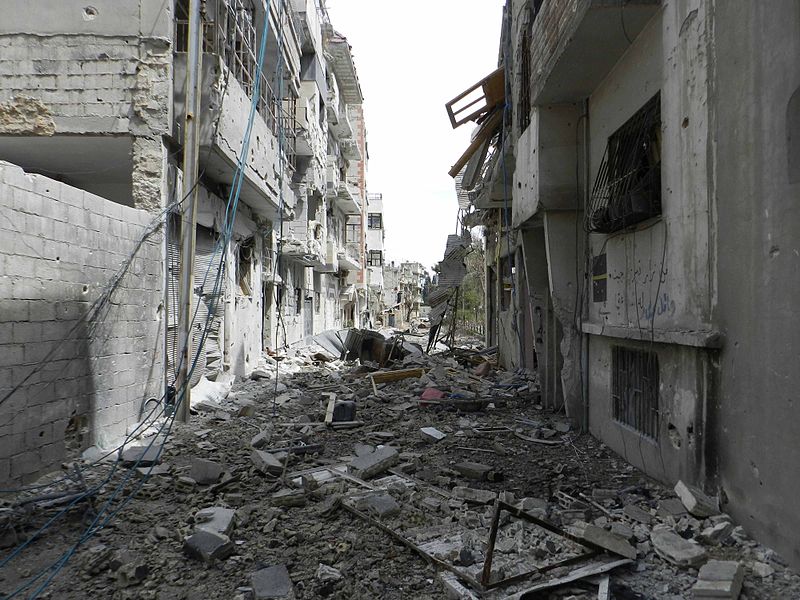In the most recent cinematic installment of James Bond, Skyfall, Bond’s hunt for the bad guys takes him to Shanghai. The trail leads him to a casino (where else?), where he finds himself in a sticky situation: while brawling with thugs Bond is knocked to the floor and a villain is able to get his hands on Bond’s pistol. The bad guy takes aim at Bond and pulls the trigger. Nothing happens.
Fortunately for Bond, Q (the tech guy) gave him a gun that will only fire when it senses Bond’s fingerprint. The bad guy finds the weapon useless and Bond is able to take him out — with the help of some conveniently placed Komodo Dragons.
It may not be obvious, but this scene has some deep implications for small arms proliferation and how we go about arming rebels (or questionable foreign governments). Yes, if we’re going to arm rebels, we should do it right: with some sensible gun control. Exercising greater caution when providing weapons would help limit the number of deaths in conflict. As evident from President Obama’s recent announcement of new gun control initiatives, gun control within the US is a sensitive subject but gun control abroad shouldn’t be, since the Second Amendment doesn’t apply.
This issue has come to the fore recently with the Arab Spring uprisings and the fear of weapons falling into the hands of radical Islamists. Arms given to rebels fighting against Ghaddafi in Libya made their way to such extremists (we are now learning this was a purposive move by United States’ ally, Qatar, who provided the weapons). Similarly, the US has been reluctant to provide weapons to the rebel Free Syrian Army in Syria for fear that weapons could end up in the hands of Al Qaeda-affiliated militias. The US faces a dilemma: by not providing arms, we may limit blowback (e.g., we gave weapons to the Afghan mujahedeen, some of whom later morphed into the Taliban), but perhaps at the price of limited US influence with more legitimate rebels.
There are technological solutions available to distribute weapons more safely that limit their future uses and allow Western arms donors to retain some control. Every coffeemaker today is programmable and there are smartphone apps for remote control toy cars (and even drones). Domestic gun control advocates have already adapted these kinds of technologies, several of which could be practical for guns that are shipped abroad. We could design guns that require particular off-caliber rounds that only the US produces or guns that cease to function after firing a certain number of rounds until they are reset with an access code (lest we forget that all our razor blades are made to go dull). That way, if rebels use up their rounds and want more, they will have to come back and ask for them — the weapons won’t be perpetually useful should they end up with hostile actors. However, US influence over rebels via the provision of controlled weapons may still be limited if arms are available by other means and are not in short supply. Therefore, the more international partner countries that join such an effort, the more effective it will be.
Given that we are likely to continue providing arms to actors in situations where we face a principal-agent problem of being unable to monitor their future actions, it seems incumbent upon us to do this in a smarter way. I’m sure Bond would agree.






4 comments
“. . . gun control within the US is a sensitive subject, but gun control abroad shouldn’t be, since the Second Amendment doesn’t apply.”
You must not have seen the NRA’s position on the Arms Trade Treaty.
A bit OT, but “razor blades are made to go dull” ? In all cutting devices there’s a tradeoff between sharpness and edge retention. This is not a corporate conspiracy, just simple metallurgy.
“Arms given to rebels fighting against Ghaddafi in Libya made their way to such extremists (we are now learning this was a purposive move by United States’ ally, Qatar, who provided the weapons). ”
Not so much. The overwhelming majority of weapons in the hands of the limited number of extremists in Libya are from looted Libyan stockpiles. Moreover, the bulk of Qatari assistance did not go to militant Salfist/jihadist groups. Outside assistance in Libya has played a negligible role in post SALW proliferation problems.
With regard to self-limiting guns, it is the sort of thing that sounds nice in the abstract but wouldn’t work well on the battlefield. Off-calibre guns could actually prove a liability for friendly rebels, making them far more vulnerable to interdiction of supply lines. Alternative producers of the ammunition would soon appear. Self-limiting devices would likely make guns less reliable, or could simply be removed. I sure as hell wouldn’t want to go into a firefight with a weapon that might stop working either because it had reached some preset limit, or because its “limiter” had malfunctioned under field conditions.
Finally, it is hard to see how the provision of small arms in (say) Syria could have much blowback, given the hundreds of thousands of weapons already in local and subregional circulation. Would there be substantial risk In Syria from the provision of MAPADS? Yes. Mortars and ATGMs? Probably. Assault rifles and ammunition? Not really.